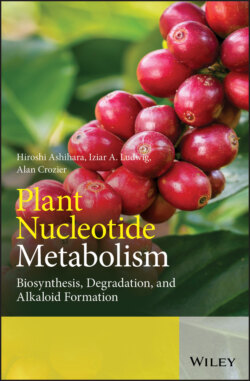Читать книгу Plant Nucleotide Metabolism - Hiroshi Ashihara - Страница 71
5.3.2 Hypoxanthine/Guanine Phosphoribosyltransferase
ОглавлениеHGPRT (IMP/GMP): diphosphate phospho-D-ribosyltransferase, EC 2.4.2.8) catalyses the formation of IMP (or GMP) from inosine (or guanine) and PRPP. Although HGPRT activity is generally high in mammalian tissues (Adams and Harkness 1976), in plants it is usually much lower than that of APRT (Table 5.1).
Figure 5.2 Reactions involved in purine salvage in plants. Reaction 1: phosphoribosyltransfer reaction: this reaction transfers the 5-phosphoribosyl group from PRPP to the purine (adenine phosphoribosyltransferase reaction is shown as an example). Reaction 2: kinase reaction: the transfer of γ-phosphate from ATP to purine nucleoside leading to formation of nucleoside monophosphate (example, adenosine kinase reaction). Reaction 3: non-specific nucleoside phosphotransferase reaction. Nucleoside 5′-monophosphate is used for this transfer reaction. Reaction 4: Purine nucleosidase enzyme reaction. Purine nucleoside is hydrolysed forming purine base and ribose.
Table 5.2 Properties of the native and recombinant adenine phosphoribosyltransferase (APRT) and hypoxanthine/guanine phosphoribosyltransferase (HGPRT) from plants.
| Km values (μM) | |||||||||||
| Enzyme | Enzyme source | Isozyme | Optimum pH | A | PRPP | tZ | iP | BA | Gene | TAIR locus | Reference |
| APRT | Jerusalem artichokea) | 5.5–6.5 | 5.5 | 64 | Le Floc'h and Lafleuriel (1978) | ||||||
| Strawberrya) | 7.5 | 10 | 130 | Robert and Pétel (2000) | |||||||
| Catharansus roseus a) | 7.6–8.0 | 7.0 | 9.6 | Hirose and Ashihara (1983) | |||||||
| Brassica juncea a) | 9.2 | 3.8 | 15 | Moffatt and Somerville (1990) | |||||||
| Wheat germa) | 7.5 | 74 | c) | 130 | 154 | Chen et al. (1982) | |||||
| Tomato rootsa) | ∼8 | 4.0 | 2.0 | 50 | Burch and Stuchbury (1986) | ||||||
| Tomato leavesa) | ∼9 | 2.0 | 1.0 | 125 | |||||||
| Hevea brasiliensis a) | 7.0 | 3.8 | 250 | Gallois et al. (1996) | |||||||
| Prunus persica | 8.5 | 0.7 | 25 | 300 | c) | Lecomte and Le Floc'h (1999) | |||||
| Arabidopsis thaliana a) | 8.8 | 4.5 | 290 | c) | c) | Lee and Moffatt (1993) | |||||
| A. thaliana b) | APT1 | 8.8 | 1.0 | 55 | 1800 | 2500 | 2400 | apt1 | AT1G27450 | Allen et al. (2002) | |
| APT2 | 7.4–7.5 | 2.6 | 330 | 110 | 15 | apt2 | AT1G80050 | Zybailov et al. (2008) | |||
| APT3 | 7.4–7.5 | 0.8 | 76 | 440 | 370 | apt3 | AT4G22570 | ||||
| APT4 | apt4 | AT4G12440 | |||||||||
| APT5 | apt5 | AT5g11160 | |||||||||
| HGPRT | HX | G | X | PRPP | |||||||
| Jerusalem artichokea) | 7.5–8.5 | 6.1 | 5.5 | 8.8 | Le Floc'h and Lafleuriel (1981) | ||||||
| A. thaliana b) | 176 | 29 | c) | hpt/gpt | AT1G71750 | Liu et al. (2007) |
A, Adenine; PRPP, 5-phosphoribosyl-1-pyrophosphate. Cytokinin bases: BA, benzyladenine; iP, isopentenyladenine; tZ, trans-zeatin. HX, Hypoxanthine; G, guanine; X, xanthine.
—, not determined.
a) Native enzyme.
b) Recombinant enzyme.
c) Activity was detected but no data was published on the Km value.
Compared with APRT, only a few kinetic analyses of HGPRT activity have been carried out with plant enzymes (Table 5.2). A native HGPRT, partially purified from Jerusalem artichoke shoots, exhibited the low Km values for hypoxanthine, guanine, and PRPP (<10 μM), which have high affinities for the enzyme. The rate of IMP formation from hypoxanthine was greater than GMP production from guanine. Enzyme activity was inhibited by the products, IMP and GMP (Le Floc'h and Lafleuriel 1981).
Molecular and functional analysis of HGPRT of A. thaliana was carried out by Liu et al. (2007). The kinetic analysis of the recombinant HGPRT revealed that the enzyme catalyses the conversion of guanine and hypoxanthine to their respective nucleoside monophosphates, but that xanthine is not a substrate. The Km values of the recombinant enzyme for hypoxanthine and guanine were 176 and 29 μM, respectively. The relatively low affinity of the A. thaliana recombinant enzyme for hypoxanthine is different to that from other sources, including humans (Keough et al. 1999) and yeast (Ali and Sloan 1982), as well as the native plant enzyme (Le Floc'h and Lafleuriel 1981), which displays similar Km values (<10 μM) towards guanine and hypoxanthine. The reason why the recombinant A. thaliana HGPRT possesses a substantially higher affinity for guanine than for hypoxanthine remains to be resolved. Like the enzymes in humans and yeast, A. thaliana HGPRT does not act on xanthine (Liu et al. 2007).
